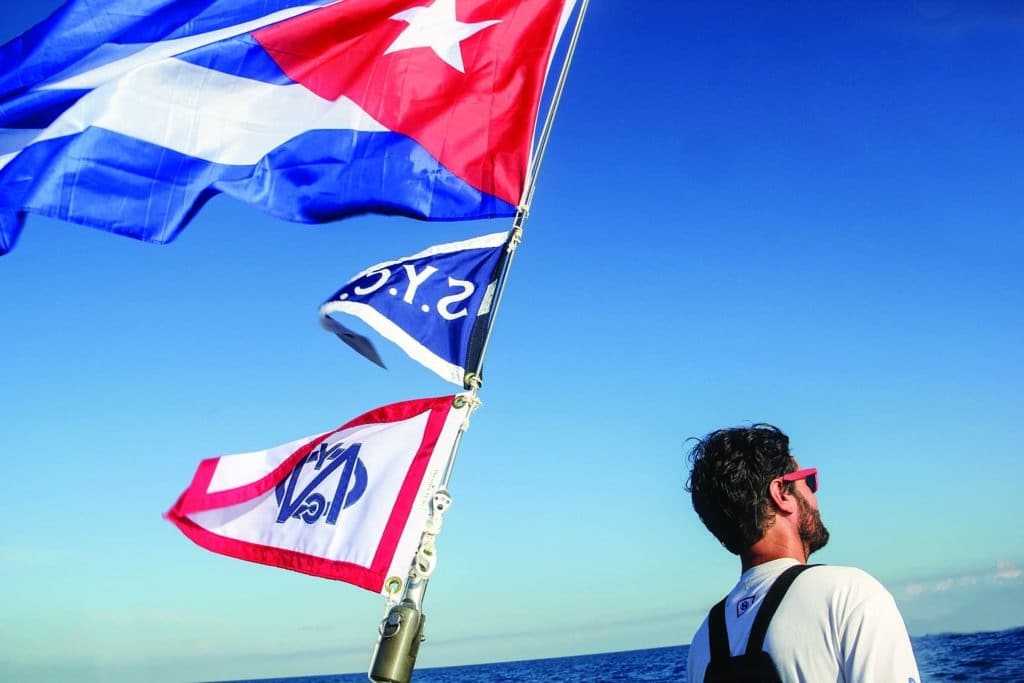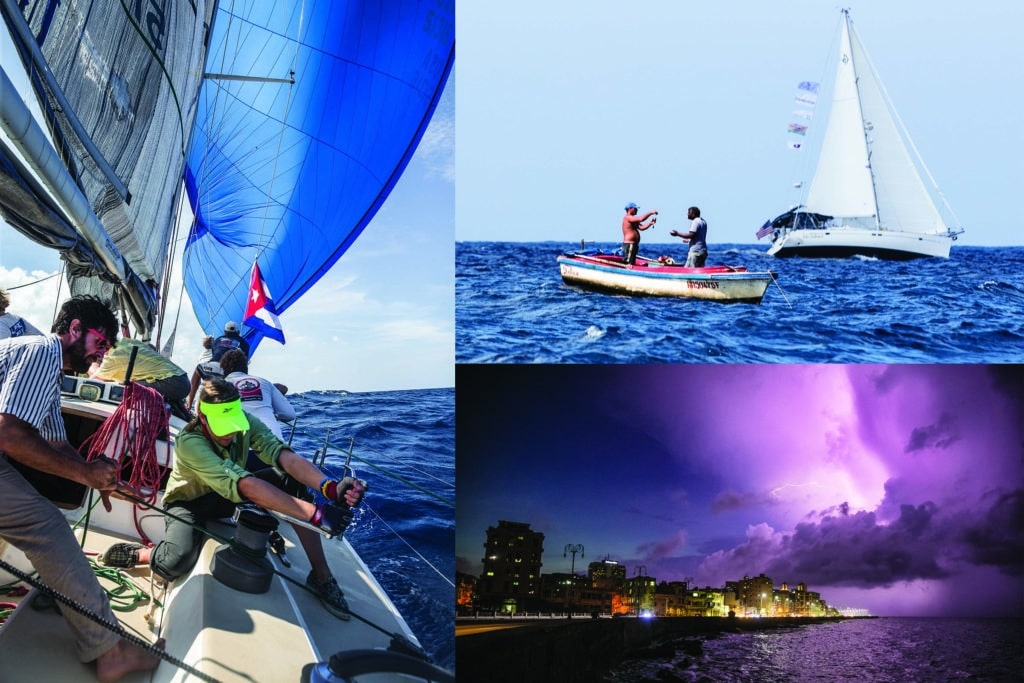
Neil and Janet Davies had spent two months preparing their Hunter 42, Midnight Sun II, for Pensacola YC’s race to Havana, Cuba, but less than 12 hours into the 517-nautical-mile race, in a steady 25 knots and six-foot seas, all that prep was for naught. Illuminated by the hazy beam of a flashlight, Midnight Sun’s crew stood by with bolt cutters and knives in hand, watching their mast slip into the Gulf of Mexico. They were dead in the water, out of the historic race that would send the first major fleet of Americans in decades onto the shores of the most elusive Caribbean island nation. Once clear of the jettisoned rig, they motored north, defeated — or so they thought.
Farther down the racetrack, the J/130 Lesson #1 was in rough shape too. The scratch entry of the 22-boat armada had no electronics and was essentially sailing the course blind, save for its solar-powered compass. Its mainsail was tattered, haphazardly lashed to the boom, and the crew sat silently in the dark cockpit, contemplating their next move as they continued to sail south with only a No. 1 jib. The race finish at Marina Hemingway was roughly 200 miles away, and they were nearing the 3-knot boost of the Loop Current, the dominant fixture of the Gulf of Mexico, which would push them straight to Havana. The mood was somber disappointment as they limped along, waiting for daylight to make a true damage assessment. Nobody ever said it would be easy racing to Cuba.
Regattas to Havana have a long history and rich lore along the Gulf Coast, with distance races first sailed from St. Petersburg, Florida, on large schooners. The inaugural race in 1930 started with 11 boats, and the crews, led by wealthy industrialists and bankers, were a who’s who of the South’s sailing scene. In the 1952 race, teams crossing the finish line in Havana were greeted by Col. Fulgencio Batista’s erupting coup d’état. Gunfire exchanges peppered the sails of exhausted skippers and crews as they crossed the finish in the harbor, only to meet tanks and soldiers on the quays in Old Havana. When Fidel Castro and his revolution conquered the island nation in 1959, heavily armed revolutionaries prevented American racers from leaving their sloops. That was the end of the races to Communist Cuba.
It took more than 30 years for regattas to resume, but anti-Castro protesters harangued racers to no end. American newspaper editorials called them “stooges of Castro,” and race organizers received bomb threats. Before the start of the 1994 Sarasota to Havana Race, underwater scuba teams scoured the hulls of competing sailboats before allowing them to start.
Races to Cuba were further curtailed by executive presidential action in 2003. It wasn’t until the surprise rapprochement between the United States and Cuban governments in late 2014 that a regatta fleet again sailed the 90 miles from Key West to Havana, on Hobie catamarans last May, quickly followed by the race from Pensacola in October.
The only thing that greeted Pensacola YC’s sailors was a strong cold front that brought heavy seas and winds as they streamed south into the Gulf. As daylight on the third morning allowed a thorough assessment of the mainsail on Lesson #1, two sailmakers on board went to work. With only two months of preparation before the race, the chartered boat had undergone an extensive refit, including a bottom job, saildrive replacement, rig tune, engine rebuild and a new No. 3 jib. In the limited time available, reef points had been added to the boat’s five-year-old Technora mainsail. With the wind on the nose at a steady 25 knots for nearly two days, however, the sail parted. Things weren’t going as well as planned for this experienced crew, which had already lost power from a brand-new alternator failing the day before.
At first light, sailing soloist Ryan Finn and professional sailmaker Bryan Whited tried to rig the No. 3 headsail as a trysail, but they underestimated the loads of the jury rig, and the sail became unmanageable when a block exploded. When the wind slackened, Finn and Whited devised an alternative using the batten above the rip where most of the blowout was, essentially making a second reef point and leaving themselves with half of the mainsail. The remainder of the sail below the batten was cut away, and after a few tries and hours of hand-sewing through the batten pocket and lashing it to the boom, the repair appeared mostly stable — “mostly” being the operative word.
Hobbled and unsure of how long the repairs would last, Lesson #1 continued on while debating the various steps required to tack or jibe what was christened the “Frankenmain.” The crew’s race strategy was simple: cover the rest of the fleet and hope to be first to finish.
The previous summer, the process for approval from the United States government to travel to Cuba, including from the Coast Guard and the State Department, had been an ordeal unto itself (although the process is much more streamlined today). For the crew on Midnight Sun II, the nine-hour return to Pensacola gave them plenty of time to contemplate their now-useless paperwork and their options. A few of Davies’ crew owned a Beneteau 473, docked in Pensacola, so one option was transferring all their gear, safety equipment and provisions onto it and setting out again, perhaps cruising elsewhere. After all, everyone had already taken vacation days.
They discussed going to the Keys or New Orleans, and then settled on the Keys, but after about two days heading south in the Gulf on the Beneteau, they accepted the potential consequences of rejoining the race with an improperly documented vessel and continued sailing toward Havana.
Hundreds of miles ahead, the crew on board Lesson #1 continued through the heavily trafficked Florida Straits with only a trickle charge from the solar panel feeding the batteries. They had no weather routing or instruments — only the battery-powered Velocitek and a highly suspect jury-rigged mainsail. But by the morning of the fifth day at sea, they entered the electric-blue Cuban territorial waters, greeted by dolphins on the bow, and initiated radio contact with Cuban authorities: “Sailing vessel Lesson Numero Uno for Marina Hemingway … Lesson Numero Uno for Marina Hemingway?” There was never a reply, but there was certainly an air of being watched.

Soon, the largest island in the Caribbean emerged on the horizon, its lush, tropical coastal heights coming into view and revealing what the first Spanish explorers described in the 16th century as “a magnificent island crowned in palms.” The first visible man-made structure was the massive Russian Embassy, rising high in its old Brutalist Soviet architectural style, radar antennas all ominously pointing north.
The race finish was a sea buoy marking the entrance to an extremely narrow channel into Marina Hemingway. All crews had been advised to not enter at night, but two small committee boats were on station, one tasked to guide each finisher through the man-made channel and straight to customs. Upon docking, there was apprehension among the customs and military officials and the exhausted crew of Lesson #1. But once the boat was cleared, Cuba Libres, the national drink of rum and cola, were passed to all on board — international relations established.
Other than two powerboats from nearby Club Nautico Internacional Hemingway de Cuba, the only Cuban-flagged watercraft was a small dinghy maneuvered by two old fishermen. Such a dinghy is indeed a rare sight in Cuba; the local media greeted the docking crews and quietly asked for photos of Havana from the water, as most have never seen their city from offshore. The local media coverage of the fleet’s arrival was extensive, and the American sailors were warmly welcomed as celebrities of sorts.
Located just a quick 7-mile dash in a 1953 Chevrolet down palm-lined boulevards to Old Havana, Marina Hemingway and the yacht club form an expansive and modern complex equipped to handle vessels up to 50 feet. With power and water hookups, it’s an ideal base from which to explore the city and launch day trips deeper into the island’s reaches.
Cuba is massive compared to its nearest neighbors, Puerto Rico, Haiti and the Dominican Republic, and while it’s very much a Caribbean island, Havana feels more like it belongs to the old quarters of Spain or Portugal. Stones from the Sierra Maestra and limestone from the coast give its architecture an enduring feel, with narrow cobblestone streets and sprawling town squares seemingly tossed around every few blocks. It’s as if gatherings and revolutions should be weekly events in every neighborhood.
The old wealth of this port city — trapped in time, and built from the gold and silver extracted by the conquistadors and brought to Havana on galleons from throughout the Americas — is highlighted by the Morro Castle, a fortress guarding the entrance to the city’s natural harbor.
Races to Havana may be seen as the primary Cuban sailing event, but the raison d’être for many sailing visitors — at least according to the United States government’s paperwork, with a checkbox for amateur sporting events — is the Regata Castillo del Morro, an afternoon lap that serves as an official cultural exchange.
As Davies and Midnight Sun II finally landed at Marina Hemingway, rested crews motored out of the marina and hoisted sails again. Among the American entries were three Cuban-flagged keelboats. The 6-mile buoy race took competitors along Havana’s rocky coastline, out to a mark in the shadow of the Morro Castle and back. It was a sporting but casual race, without handicap. Everyone started at once, with spectators lining Havana’s famed Malecon and cheering on this unusual spectacle of American yachts racing in Cuban waters. Boats were loaded with dignitaries and racer-chasers, so it was more of a spectacle than a competitive outing. All were “scored,” however, and Lesson #1 walked away on the fleet, powered by its battle-scared Frankenmain.
That evening, with a pig turning on a spit and the rum flowing on the grounds of the Hemingway YC, regatta chairman Bob Kriegel stood with a group of dignitaries from the U.S. Embassy, the Cuban government, and the Pensacola and Hemingway yacht clubs. Before the trophies were doled out, Commodore Jose Miguel Diaz Escrich spoke passionately through an interpreter.
“This regatta, and the ones to follow, will only broaden and strengthen the relations of friendship and cooperation between not only our yacht clubs but also the people of our two nations,” he said. “Cubans and Americans have always been connected, and I will tell you now with all sincerity, there has never been a single American flag burned on Cuban soil … and there never will be.”
The assembly became electric. Everyone stood and cheered, in agreement that Havana is about to become familiar to American sailors again. The door is open wide at the Hemingway YC, and the limes and sugarcane are waiting.









